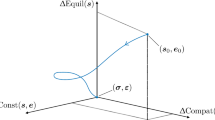Abstract
Based on the complementary potential energy variational principle, in this work, we proposed a stress-driven homogenization procedure to compute overall effective material properties for elastic composites with locally heterogenous micro-structures. We have developed a novel incremental variational formulation for homogenization problems of both infinitesimal and finite deformations where the macro-stress-based complementary potential energy is obtained for hyperelastic materials for a global minimization problem with respect to fine-scale displacement fluctuation field. The point of departure of our approach is a general complementary variational principle formulation that can determine material responses of elastic composites with heterogeneous micro structures. We have implemented the proposed stress-driven computational homogenization procedure with the finite element method. By comparing the numerical results with the analytical method and the strain-driven homogenization method, we find that the stress-driven homogenization offers the lower bound estimate of materials properties for elastic composites.







Similar content being viewed by others
References
Hill R (1963) Elastic properties of reinforced solids: some theoretical principles. J Mech Phys Solids 11(5):357
Hill R (1972) On constitutive macro-variables for heterogeneous solids at finite strain. Proc R Soc Lond A Math Phys Sci 326(1565):131
Willis JR (1981) Variational and related methods for the overall properties of composites. In: Advances in applied mechanics, vol 21, Elsevier, pp 1–78
Castaneda PP, Suquet P (1997) Nonlinear composites. In: Advances in applied mechanics, vol 34, Elsevier, pp 171–302
Li S, Wang G (2008) Introduction to micromechanics, introduction to micromechanics. World Scientific, Singapore
Sánchez-Palencia E (1980) Non-homogeneous media and vibration theory. Lecture notes in physics 127
Bensoussan A, Lions JL, Papanicolaou G ( 2011) Asymptotic analysis for periodic structures, Asymptotic analysis for periodic structures, vol 374 (American Mathematical Soc.)
Terada K, Hori M, Kyoya T, Kikuchi N (2000) Simulation of the multi-scale convergence in computational homogenization approaches. Int J Solids Struct 37(16):2285
Geers M, Kouznetsova V, Brekelmans W (2010) Multi-scale computational homogenization: trends and challenges. J Comput Appl Math 234(7):2175
Miehe C, Schröder J, Schotte J (1999) Computational homogenization analysis in finite plasticity simulation of texture development in polycrystalline materials. Comput Methods Appl Mech Eng 171(3–4):387
Miehe C (2002) Strain-driven homogenization of inelastic microstructures and composites based on an incremental variational formulation. Int J Numer Methods Eng 55(11):1285
Eshelby JD (1957) The determination of the elastic field of an ellipsoidal inclusion, and related problems. Proc R Soc Lond Ser A Math Phys Sci 241(1226):376
Li S, Wang G, Sauer R (2007) The Eshelby tensors in a finite spherical domain Part II: applications to homogenization. ASME J Appl Mech 74:784
Suquet P (1985) Elements of homogenization for inelastic solid mechanics, homogenization techniques for composite media. In: Lecture notes in physics, vol 272, Springer, p 193
Moulinec H, Suquet P (1998) A numerical method for computing the overall response of nonlinear composites with complex microstructure. Comput Methods Appl Mech Eng 157(1–2):69
Miehe C (2003) Computational micro-to-macro transitions for discretized micro-structures of heterogeneous materials at finite strains based on the minimization of averaged incremental energy. Comput Methods Appl Mech Eng 192(5–6):559
van Dijk N (2016) Formulation and implementation of stress-driven and/or strain-driven computational homogenization for finite strain. Int J Numer Methods Eng 107(12):1009
Javili A, Saeb S, Steinmann P (2017) Aspects of implementing constant traction boundary conditions in computational homogenization via semi-Dirichlet boundary conditions. Comput Mech 59(1):21
Hashin Z, Shtrikman S (1962) A variational approach to the theory of the elastic behaviour of polycrystals. J Mech Phys Solids 10(4):343
Hashin Z, Shtrikman S (1963) A variational approach to the theory of the elastic behaviour of multiphase materials. J Mech Phys Solids 11(2):127
Author information
Authors and Affiliations
Corresponding author
Additional information
Publisher's Note
Springer Nature remains neutral with regard to jurisdictional claims in published maps and institutional affiliations.
Rights and permissions
About this article
Cite this article
**e, Y., Li, S. A stress-driven computational homogenization method based on complementary potential energy variational principle for elastic composites. Comput Mech 67, 637–652 (2021). https://doi.org/10.1007/s00466-020-01953-8
Received:
Accepted:
Published:
Issue Date:
DOI: https://doi.org/10.1007/s00466-020-01953-8



